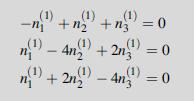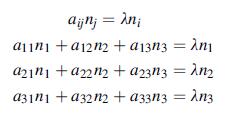Explicitly show that the stress state given in Example 3.1 will reduce to the proper diagonal form
Question:
Explicitly show that the stress state given in Example 3.1 will reduce to the proper diagonal form under transformation to principal axes.
Data from example 3.1
For the following state of stress, determine the principal stresses and directions and find the traction vector on a plane with unit normal n = (0, 1, 1)/ √2:

The roots of this equation are found to be σ = 4, 1, –2. Back substituting the first root into the fundamental system [see (1.6.1)] gives:

Equation 1.6.1

Solving this system, the normalized principal direction is found to be n (1) = (2, 1, 1)/ √6. In similar fashion the other two principal directions are n (2) = (–1, 1, 1)/ √3, n (3) = (0, –1, 1)/ √2. The traction vector on the specified plane is calculated by using the relation:
![3 T = 1 0 2 1 20 1/2 [1/] = [2/2 2/2 2/2](https://dsd5zvtm8ll6.cloudfront.net/images/question_images/1704/8/7/4/727659e52e75fc851704874726294.jpg)
Step by Step Answer:

Elasticity Theory Applications And Numerics
ISBN: 9780128159873
4th Edition
Authors: Martin H. Sadd Ph.D.





